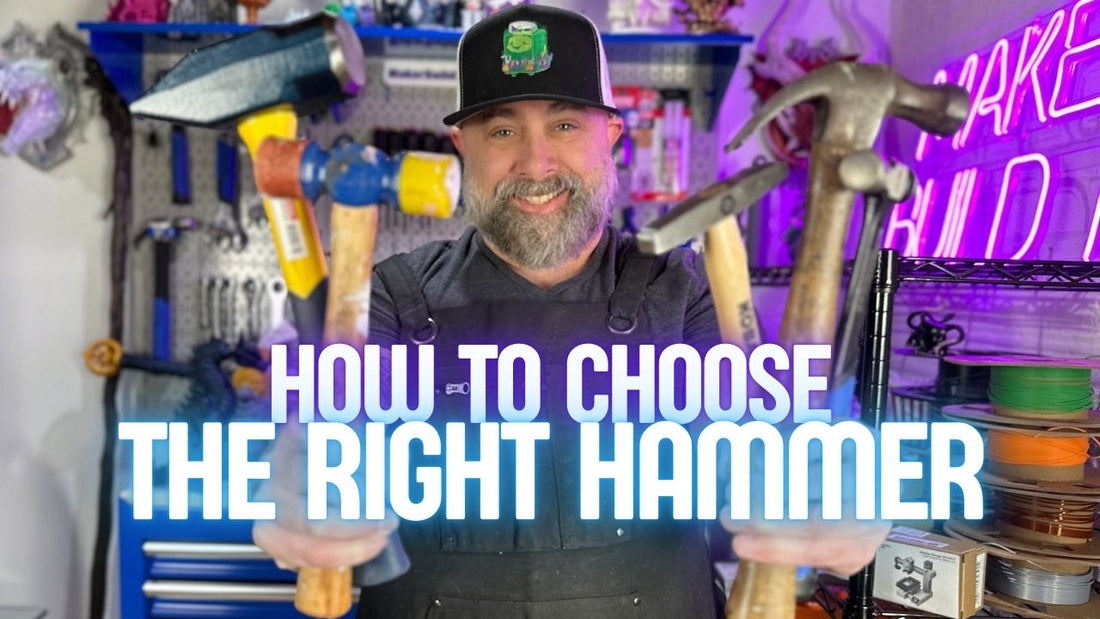If you’ve ever spent time in a workshop, garage, or DIY space, you’ve probably realized that not all hammers are created equal. Whether you’re building furniture, forging metal, or assembling a cosplay prop, the right hammer can make a world of difference. In this guide, we’re breaking down different types of hammers, their uses, and which ones you should have in your toolbox.
The Claw Hammer – A Must-Have for Every DIYer
The claw hammer is the go-to tool for most DIYers. If you have only one hammer in your toolbox, this is probably it. It’s primarily used for driving and removing nails, assembling furniture, and general construction tasks.
A claw hammer features:
✔ A flat striking surface on one side for driving nails.
✔ A curved claw on the other side to pull out nails or pry apart materials.
What to Look For in a Claw Hammer:
• A solid steel head for durability.
• A wood or fiberglass handle to absorb vibrations.
• A comfortable grip to reduce hand fatigue.
The Ball Peen Hammer – Ideal for Metalworking
If you work with metal, a ball peen hammer is a must-have. It’s designed for riveting, shaping, and hardening metal without causing cracks or deformities.
This hammer features:
✔ A rounded end for shaping and spreading metal.
✔ A flat striking surface for general hammering tasks.
Best Uses for a Ball Peen Hammer:
• Blacksmithing and metal fabrication.
• Shaping metal sheets and jewelry making.
• Riveting and forging.
When choosing a ball peen hammer, look for one with a steel head and a wood, steel, or fiberglass handle for better durability and control.
The Rubber Mallet – A Gentle Yet Effective Tool
Sometimes, you need a hammer that can deliver a firm impact without damaging the material. That’s where a rubber mallet comes in handy.
A rubber mallet is great for:
✔ Closing paint cans without denting the lid.
✔ Tapping parts together without cracking or scratching them.
✔ Woodworking projects where you don’t want to leave hammer marks.
✔ Assembling 3D prints and cosplay props, especially when working with key and cut connections.
Most rubber mallets have a solid rubber head, but some models include a hard plastic head for more versatility. If you’re looking for one, make sure it has a sturdy wood or fiberglass handle for comfort and longevity.
The Blacksmithing Hammer – Heavy-Duty Power for Metalwork
For serious metalworking, a blacksmithing hammer is essential. It’s designed to forge and shape metal on an anvil.
Key features of a blacksmithing hammer:
✔ A heavy face on one side for forceful strikes.
✔ A cross peen or flat face for shaping and detailing metal.
If you’re getting into blacksmithing, this is the hammer for you. They come in various sizes and weights, so choose one that fits your specific needs.
The Tack Hammer – Precision for Small Jobs
A tack hammer is designed for small, delicate tasks like upholstery work and securing lightweight materials.
✔ Many models feature magnetic ends to hold small nails in place.
✔ At just five ounces, it’s lightweight and easy to control.
If you do a lot of fine detailing or light assembly work, having a tack hammer in your toolkit can be incredibly useful.
Which Hammers Should You Start With?
If you’re just getting started with DIY projects, here are the top three hammers you should own:
1️⃣ Claw Hammer – The everyday essential for general construction and repairs.
2️⃣ Rubber Mallet – Perfect for delicate work, 3D prints, and soft materials.
3️⃣ Ball Peen Hammer – Great for precise metalworking and shaping.
While there are many other specialty hammers—like bricklayer’s hammers, drywall hammers, and roofing hammers—these three core hammers will cover most DIY needs.
Whether you’re woodworking, metalworking, or assembling 3D prints, having the right hammer can make a huge difference in your projects. The right tool will help you achieve better results with less effort and less frustration.
Do you have a favorite hammer or a project where one type of hammer worked better than another?

